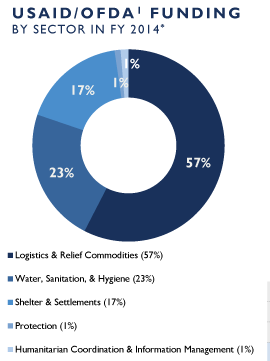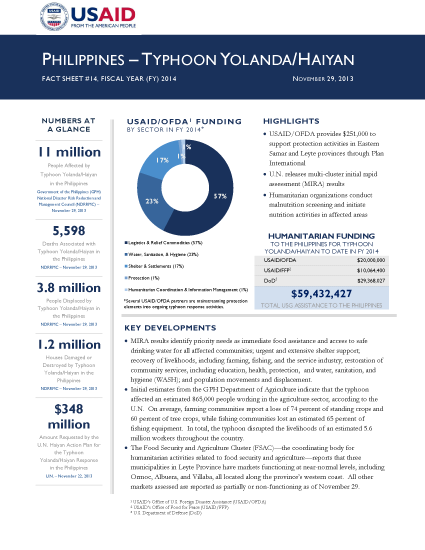- What We Do
- Agriculture and Food Security
- Democracy, Human Rights and Governance
- Economic Growth and Trade
- Education
- Ending Extreme Poverty
- Environment and Global Climate Change
- Gender Equality and Women's Empowerment
- Global Health
- Water and Sanitation
- Working in Crises and Conflict
- Disaster Assistance
- Political Transition Initiatives
- Conflict Mitigation and Prevention
- Countering Violent Extremism
- Disaster Risk Reduction
- Peacebuilding and Reconciliation
- Providing Safe & Secure Environments for Development
- Recovering From Crisis
- Resilience
- Tech Challenge for Atrocity Prevention
- World Humanitarian Day
- U.S. Global Development Lab
November 29, 2013
Numbers At A Glance
11 million
5,598
3.8 million
1.2 million
$348 million
Humanitarian Funding:
To The Philippines For Typhoon Haiyan/Yolanda To Date In FY2014:

| USAID/OFDA | $20,000,000 |
| USAID/FFP | $10,064,400 |
| DoD | $29,368,027 |
| TOTAL | $59,432,427 |
Typhoon Haiyan / Yolanda Fact Sheet #14 - 11/29/2013 ![]() (pdf - 218k)
(pdf - 218k)
Highlights
USAID/OFDA provides $251,000 to support protection activities in Eastern Samar and Leyte provinces through Plan International.
U.N. releases multi-cluster initial rapid assessment (MIRA) results.
Humanitarian organizations conduct malnutrition screening and initiate nutrition activities in affected areas.
Key Developments
MIRA results identify priority needs as immediate food assistance and access to safe drinking water for all affected communities; urgent and extensive shelter support; recovery of livelihoods, including farming, fishing, and the service industry; restoration of community services, including education, health, protection, and water, sanitation, and hygiene (WASH); and population movements and displacement.
Initial estimates from the GPH Department of Agriculture indicate that the typhoon affected an estimated 865,000 people working in the agriculture sector, according to the U.N. On average, farming communities report a loss of 74 percent of standing crops and 60 percent of tree crops, while fishing communities lost an estimated 65 percent of fishing equipment. In total, the typhoon disrupted the livelihoods of an estimated 5.6 million workers throughout the country.
The Food Security and Agriculture Cluster (FSAC)—the coordinating body for humanitarian activities related to food security and agriculture—reports that three municipalities in Leyte Province have markets functioning at near-normal levels, including Ormoc, Albuera, and Villaba, all located along the province’s western coast. All other markets assessed are reported as partially or non-functioning as of November 29.
HEALTH AND NUTRITION
- The GPH Department of Health (DoH) is organizing a fogging operation to control mosquito populations—particularly aimed at controlling mosquitoes that carry dengue and chikungunya, endemic vector-borne diseases—in typhoon-affected areas. The DoH will likely conduct fogging at schools, health facilities, and evacuation centers.
- As of November 28, 196 health teams had deployed to typhoon-affected areas, including 90 DoH teams, 23 teams from local Filipino health programs, and 80 foreign medical teams, according to the DoH. Health teams comprise 570 doctors, more than 640 nurses, and approximately 1,050 other medical personnel.
- The DoH has also deployed mental health and psychosocial services (MHPSS) teams to Tacloban city, Leyte Province, to provide family and community support services and grief processing assistance, as well as to manage psychotropic medications. In addition, the DoH has deployed MHPSS teams to Villamor Air Base in Manila to assist evacuees arriving in the city.
- Nutrition Cluster partners plan to target 12,000 children between six months and five years of age with community-based management of severe and moderate acute malnutrition, up to 40,000 children between six months and two years of age with blanket supplementary feeding programs, and 197,500 children under two years of age and pregnant women with infant and young child feeding in emergency programs over the next six months.
- Partners have initiated malnutrition screening activities in Eastern and Central Visayas regions, finding 235 cases of moderate or severe acute malnutrition among children between six months and five years of age.
Water, Sanitation, and Hygiene (WASH)
- The Philippines’ Local Water Utilities Administration has identified infrastructure damage in 68 water districts across affected provinces, according to the U.N. Office for the Coordination of Humanitarian Affairs (OCHA). Initial estimates indicate that 4.5 million people require access to life-saving WASH interventions, both within and outside of evacuation centers.
- The DoH is conducting ongoing water quality monitoring and reports that water quality is generally adequate across affected areas.
- USAID/OFDA partners report that the availability of safe drinking water is adequate, with no known outbreaks of water-borne illnesses and no observed acute water insecurity in USAID/OFDA program areas. Water tankering activities will likely begin to phase out as municipal water systems reach adequate output and access levels.
- USAID/OFDA partners indicate that access to hygiene supplies for men and women is adequate, based on observations in USAID/OFDA-focused priority zones. Catholic Relief Services (CRS) and Plan International, both USAID/OFDA partners, will continue to distribute hygiene kits as cash-for-work programs scale up and increased access to markets support more durable access to hygiene supplies.
PROTECTION
- The International Organization for Migration (IOM), in coordination with the GPH, has initiated its Displacement Tracking Matrix (DTM) in more than 80 percent of Leyte and Samar islands. IOM’s DTM is providing up-to-date information on displacement sites in 143 municipalities throughout Biliran, Cebu, East Samar, Leyte, and Samar provinces, as well as Roxas City in Capiz Province.
- USAID/OFDA is providing more than $250,000 to Plan International to support critical child protection activities, in coordination with the GPH Department of Social Welfare and Development (DSWD) and the Protection Cluster, in Leyte and Eastern Samar provinces, targeting 50,000 vulnerable individuals. With USAID/OFDA support, Plan International plans to ensure unaccompanied children are cared for in a safe and supportive family environment by supporting DSWD to establish systems for identification, registration, tracing, and unification; ensure access to mechanisms to prevent and respond to violence, abuse, and exploitation through support for referral mechanisms and training; ensure children receive psychosocial support through training of caregivers, volunteers, and humanitarian workers; establish child friendly spaces; and train community volunteers, non-governmental organizations (NGOs), and government officials on identification, registration, and referrals of separated and unaccompanied children. This funding enhances protection elements already mainstreamed by USAID/OFDA partners across ongoing typhoon response activities.
AGRICULTURE AND FOOD SECURITY
- As of November 27, the U.N. World Food Program (WFP) had dispatched a total of 4,771 metric tons (MT) of rice, 142 MT of high-energy biscuits, and 9 MT of ready-to-eat emergency food products, including paste, for approximately 3 million people. WFP is working with NGOs to scale-up general food distributions in Leyte, Panay, and Samar islands. WFP anticipates blanket supplementary feeding to begin on December 1.
- To date, DSWD has distributed nearly 1.2 million food packs, the Philippine Red Cross has distributed approximately 62,600 food parcels to 313,000 people, and other cluster partners have reached approximately 738,000 people with food assistance, according to OCHA.
- The GPH has requested support to provide approximately 1,920 MT of rice seed, 330 MT of corn seed, and 2,200 MT of fertilizer, as well as agricultural tool kits and small irrigation water pumps, to assist farmers affected by the typhoon. In response, FSAC partners are delivering nearly 614 MT of rice seed and 46 MT of corn seed to enable more than 17,600 families to plant crops during the ongoing planting season.
LOGISTICS AND RELIEF COMMODITIES
- The Logistics Cluster has transported more than 1,300 MT of cargo to Tacloban via air, road, and sea on behalf of 13 humanitarian organizations.
- In Tacloban, the Logistics Cluster is augmenting the trucking capacity of humanitarian organizations to speed up the delivery of priority relief cargo, including shelter and WASH items. The cluster has made 21 trucks available for use by the Office of the U.N. High Commissioner for Refugees (UNHCR) in recent days to help clear cargo from the Tacloban port and assist with distributions. The cluster also provided seven trucks to the U.N. Children’s Fund (UNICEF) and is moving 10 trucks from Tacloban to Guiuan municipality, Eastern Samar Province, to support relief operations.
- The Logistics Cluster is planning to facilitate the offloading and labor related to all interagency cargo arriving by sea or air into Tacloban to streamline operations and reduce congestion. The cluster will also provide onward transport to the logistics hub in Palo municipality, Leyte Province. The Logistics Cluster reports no lack of commercial overland transport in Tacloban or Cebu at this time.
SHELTER AND SETTLEMENTS
- OCHA reports that shelter materials on the local market are limited, and prices have doubled in some areas. Shelter partners have provided plastic sheeting and tents for more than 35,000 households, with plans to reach an additional 400,000 households with shelter support. To date, most shelter material distributions have occurred in Eastern Visayas Region, including Eastern Samar, Leyte, and Samar provinces.
- USAID/OFDA partners report progress on emergency shelter activities and new stocks of shelter materials arriving in country to complement the USAID/OFDA-supplied commodities. Self-recovery efforts in the shelter sector are accelerating, and partners are initiating activities to complement the relief efforts of affected populations.
INTERNATIONAL ASSISTANCE
- As of November 29, international donors had pledged nearly $393 million to address the needs of populations affected by Typhoon Yolanda/Haiyan. The total amount pledged exceeds the $348 million requested by the revised U.N. Haiyan Action Plan for the Philippines typhoon response.









Comment
Make a general inquiry or suggest an improvement.